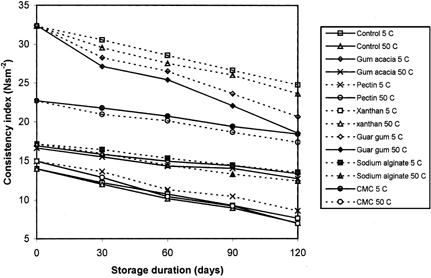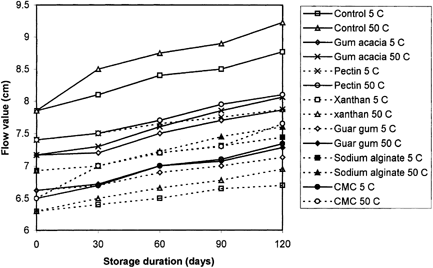ABSTRACT
A thermal diffusivity tube of similar design to that described in the literature was used to determine the thermal diffusivity of the components of a petfood product by the log method. Benchmarking experiments with commercial corned beef (α=1.09 ± 0.09 ×10−7 m2/s) over the temperature range 25–50°C were in good agreement with previously reported values. That for mashed potato (α =1.52± 0.07×10−7 m2/s) was larger than expected, although the mash had a low density (77% w/w water, 780 kg/m3). The carageenan gel component of the petfood was stable up to 65°C, and its value of 1.57±0.05×10−7 m2/s was close to that for water between 30–50°C. The meat solids, containing 10–15% (v/v) gel, gave a value of 1.25±0.12×10−7 m2/s over this temperature range.
Abbreviations
| a, b, | = |
Constants in Eq.Equation3 |
| C, p | = |
Specific heat capacity (Jkg−1K−1) |
| Fo, | = |
Fourier number, (1/N) |
| k, | = |
Thermal conductivity, (Wm−1 K−1) |
| l, | = |
Length, (m) |
| R | = |
Radius, (m) |
| T,T s | = |
Temperature, surface temperature, (K) |
| t, | = |
Time, (s) |
| α, | = |
Thermal diffusivity, (m2s−1) |
| ρ, | = |
Density, (kg m−3) |
INTRODUCTION
Thermal processing of food materials for cooking and/or sterilisation is used extensively in the manufacture of many foodstuffs. Many of these processes, such as canning, involve unsteady state techniques where the material is subjected to a spatially and temporally variant temperature field. The mathematical basis of thermal processing is well established Citation[1], but improvements in the design and optimisation of such processes require reliable thermo-physical property data. For instance, the thermal diffusivity, α, is a key parameter in the canning process. Accurate predictions of α are not yet available for many semi-solid and multi-phase food materials, so that experimental determinations are required. Several methods for measuring α are available, as discussed by Magee and Bransburg Citation[2], but not all are suitable for inhomogeneous foodstuffs. This work was concerned with petfood materials, the product featuring large [o(1 cm)] chunks of particulate (meat) materials in a gel matrix. Such materials pose particular problems in thermal processing, as the length scales involved are rarely large enough to allow the material to be approximated as a continuum. Estimates of α were therefore obtained using a thermal diffusivity tube similar to that reported by Magee and Bransburg Citation[2], based on that described by Dickerson Citation[3]. Repeated measurements were taken in order to establish the variation with packing between tests.
EXPERIMENTAL METHODS
The log-method for determination of thermal diffusivity employs an approximate solution to the following equation describing unsteady state heat transfer in an isotropic solid
If k is isotropic and independent of temperature over the range of interest, then
The solution of Eq.Equation2 for an finite cylinder of material at a uniform initial temperature T i , exposed to a different external temperature T s at time 0 consists of a series of terms described in detail elsewhereEquation1. For a long exposure time, denoted by Fo=αt/R 2≥0.15, the solution at the centre (r=0) can be approximated by an exponential decay, of the form
where
The cylinders used by Magee and Bransburg Citation[2] and in the current work approximate to infinite cylinders as the second term on the RHS of Eq.Equation4 was small, at ∼1/100×the first term. Axial temperatures were measured near the midpoint of the device.
Figure shows a schematic of the apparatus. The thermal diffusivity tube was constructed from copper with dimensions 270 mm×50 mm i.d. The end-pieces were made of Perspex and fitted with guides so that the thermocouples (bayonet, type K, calibrated to±0.5°C) could be aligned precisely along the axis. The external (surface) temperature was measured using two thin foil thermocouples (Rhopoint, Oxford;±0.5°C) bonded to the tube. The device differs from that reported by Magee and Bransburg Citation[2] in diameter (50 mm cf. 25 mm), number of thermocouples (4 cf. 2) and the use of thin foil temperature sensors. The penetration of the bayonet thermocouples was varied between 0–30 mm from the centre of the tube, and the difference in temperatures for any pair of measurements lay consistently within the accuracy range of the sensors.
Figure 1. Plan view of thermal diffusivity tube apparatus. A – thermocouple alignment device; B – perspex end cap; C – bayonet thermocouple; D – thin foil surface thermocouple; E – water bath wall.

The device was mounted through the wall of a lagged 25 litres HDPE bath fitted with a temperature controller and agitator. Experiments were started from ambient conditions by adding 15 litres of water heated to the desired external temperature. Trials established that the difference between the surface temperature and the desired bulk liquid temperature did not vary by more than 0.5°C during an experiment.
The benchmarking materials used in this study were corned beef (Sainsbury's own label) and mashed potato (Estima variety). The potatoes were cooked in salted boiling water for 15 minutes, drained and mashed in a blender. The petfood gel was prepared was adding 7.5 g carrageenan, 5.0 g carob gum and 3.75 g KCl to 1000 mL pH 6.3 buffer under constant agitation. The finely dispersed suspension was diluted further with 250 mL buffer, heated with stirring to 96°C for 15 minutes, then allowed to set in situ. The set gel was a stable brown semi-solid at temperatures below 65°C, above which the gel structure disintegrated to give a liquid of similar viscosity to water. Meat chunks of varying sizes, o(10 mm), were provided by Dalgety Petfoods. Chunks were dipped in the warm gel and packed into the diffusivity tube to give a solids volume fraction in the range 0.85–0.9. The voids between chunks were filled carefully with warm gel and the mass was allowed to cool in situ before the end cap was attached.
RESULTS AND DISCUSSION
Figure shows the data from four tests on the mashed potato material plotted according to Eq. Equation3. Each data set featured a linear profile, confirmed by linear regression coefficients (R 2)≥ 0.999. Data within the initial period (Fo≤ 0.15) and at the limit of sensor accuracy (Ts −T≤1.5) were excluded from the regression. Temperature measurement was the dominant source of error in the analysis and standard errors for sets of repeated experiments are reported.
Figure 2. Experimental data for mashed Estima potato plotted according to Eq.Equation3.

The results for the study are summarised in Table . The consistent results obtained for both reference materials indicated that the methodology was reliable. Comparison with literature values shows some of the difficulties involved in comparing food materials. The higher value for corned beef reported by Touloukian et al. Citation[4] is consistent with the larger water content of their material. The values obtained for the mashed potato were larger than that reported by Magee and Bransburg Citation[3], but the sample densities differed considerably, at 780 cf. 1110 kg/m3. The ratio of thermal diffusivities (0.85) is not inversely proportional to the ratio of densities (0.70), indicating that both C p and/or k are affected significantly by the structure. The measured value of α varied noticeably from that predicted by the correlation of Martens Citation[6], which predicted a value of 1.37×10−7 m2/s. There was not sufficient time to explore the effect of density on α for the mashed potato.
Table 1. Summary of Results
The value of α obtained for the carageenan gel was close to that for water, which was not unexpected given its low concentration. The value obtained for the meat chunks was significantly smaller, lying between that of the liquid and the meat analogue (corned beef). The standard error for the petfood mixture was noticeably larger than for the other materials, reflecting the difficulty in achieving even packing of material between experiments. The values obtained provide bounds for the expected thermal behaviour of the petfood product up to the gel breakdown temperature. Above this temperature, liquefaction of the gel and the onset of convective flows will render models based on quasi-homogeneous properties invalid.
CONCLUSIONS
A thermal diffusivity tube similar to that described by Magee and Bransburg Citation[2] has been used to measure the thermal diffusivity of the components in a commercial petfood. The method gave consistent results. The values obtained for corned beef and a carageenan-based gel were in agreement with those existing in the literature; the value obtained for mashed potato was larger than expected, partly due to the lower density of the material tested. The lumped thermal diffusivity for the petfood material can be expected to lie in the range 1.25–1.27×10−7 m2/s over the temperature range 20–50°C.
ACKNOWLEDGMENTS
The assistance of Messrs. J. Hankin, N. Butcher and T. Clark with the construction of the apparatus for this student project is much appreciated.
REFERENCES
- Holdsworth , S.D. 1997 . Thermal Processing of Packaged Foods Blackie Academic and Professional .
- Magee , T.R.A. and Bransburg , T. 1995 . Measurement of Thermal Diffusivity of Potato, Malt Bread and Wheat Flour . J. Food Eng. , 25 : 223 – 232 .
- Dickerson , R.W. 1965 . An Apparatus for the Measurement of the Thermal Diffusivity of Foods . Food Technol. , 19 : 198 – 204 .
- Touloukian , Y.S. , Powell , R.W. , Nikolai , M.C. and Ho , C.Y. 1973 . Thermal Properties of Matter – Thermal Diffusivity , TPRC Data Series Vol. 10 IFI/Plenum Data Corporation
- Tung , M.A. , Morello , G.F. and Ramaswamy , H.S. 1989 . “ Food Properties, Heat Transfer Conditions and Sterilization Considerations in Retort Processes. ” . In Food Properties and Computer-aided Engineering of Food Processing Systems Edited by: Singh , R. P. and Medina , A. G. 49 – 71 . New York : Kluwer .
- Martens , T. 1980 . Mathematical Model of Heat Processing in Flat Containers PhD thesis, Katholeike University of Belgium
- Evans , H.L. 1958 . Studies in Canning Processes. II. Effects of the Variation in Temperature on the Thermal Properties of Foods . Food Technol. , 12 ( 6 ) : 276 – 282 .